Similar to Asus' Strix, the Xtreme Editions are now on the market and if Asus uses ROG as a brand for gamers, then you have to follow up with Aorus at Gigabyte. Believe at least. In the meantime, there are also motherboards, notebooks, peripherals and gods with separate Aorus branding and without a gigabyte logo. Last but not least, it recently caught the graphics cards and we have to (again) rethink.
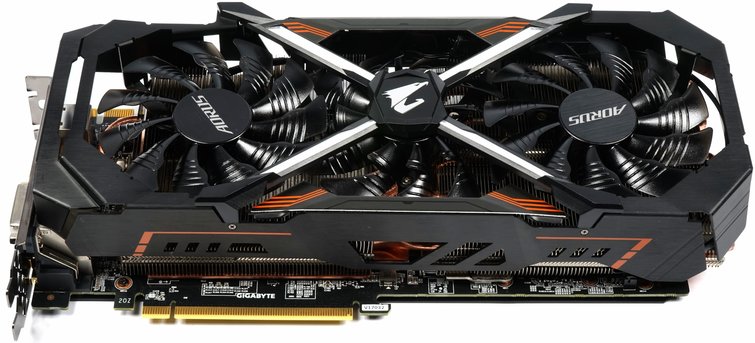
Since the specifications of the standard or Reference models ("Nvidia GeForce GTX 1080 Ti 11GB in test") don't let gaming target group-like models be staged, so it has to be a little bit more. But here we have to check again and distinguish between two BIOS versions (see below).
Since the actual performance of all board partner cards depends more on the actual boost clock achieved, and thus causally depends on the cooling, the power target and above all the quality of the respective chip, any test based only on benchmark bars is more of a Random snapshot of a single specimen. This is precisely why we have focused on the actual technical implementation of each model and have been able to document this very well with our equipment.
The retail card we tested has an unusually good chip, which could even be overclocked with an improvised water cooling over 2.1 GHz and with default settings also with well below 1 volt voltage. However, the quality is highly dependent on chance and so the charts for voltage and in places also boost clock are not transferable 1:1 to each card.
Unboxing, dimensions and connections
The card has grown again compared to the Gigabyte GTX 1080 Xtreme Gaming and the Aorus GTX 1080 Xtreme Edition (as a successor after the name change). Especially the redesigned backplate and the VRM heatsink construction are completely new, so we will go into it in more detail on the next pages. We therefore give ourselves the usual PR slides at this point.
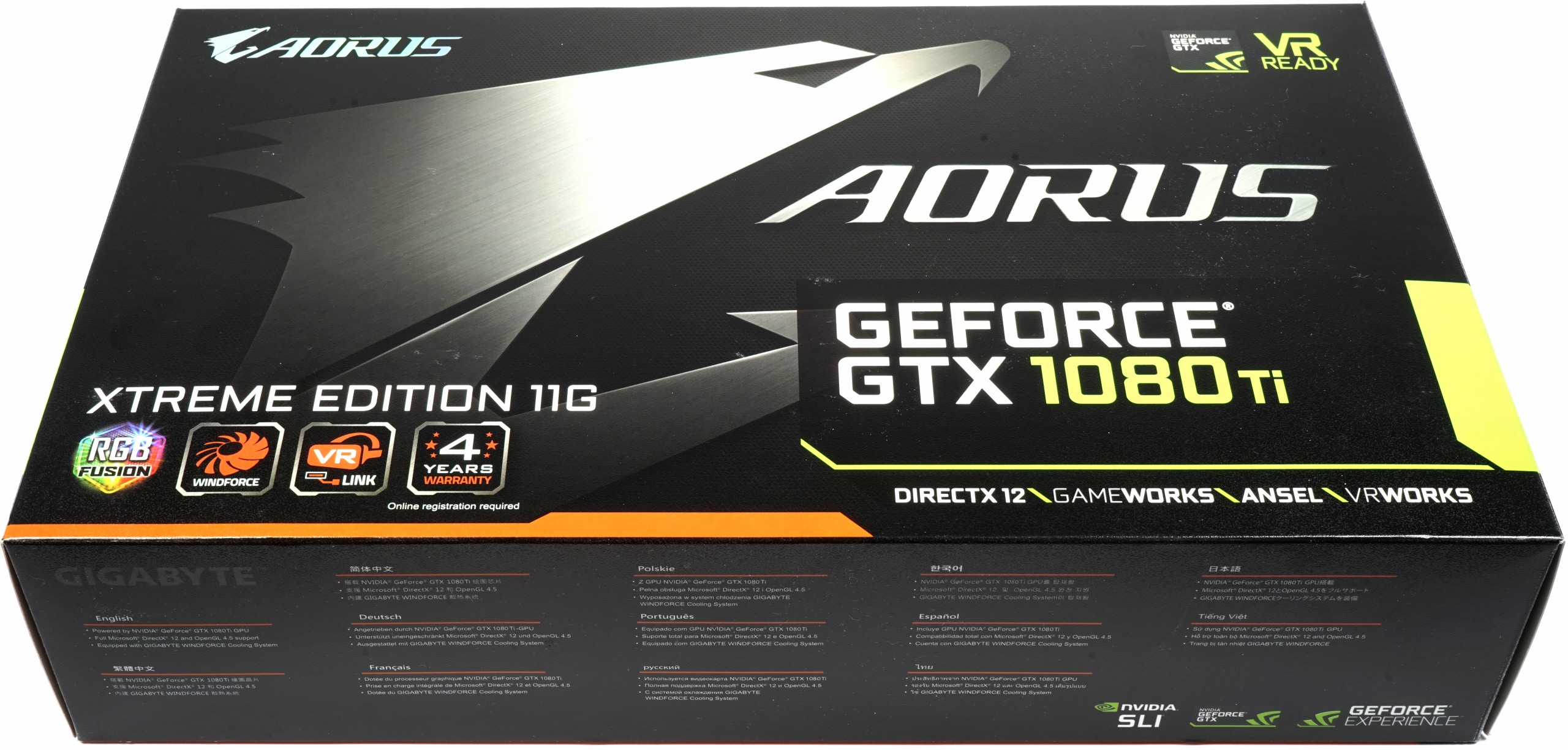
With an enormous weight of 1,443 kilos, rather average 29 cm real installation length (outer edge slot aperture to the end of the cover), a height of 13.5 cm (upper edge motherboard slot to top edge cover) and a mounting depth of a massive 5.5 cm is the 2.5 slot card a real thickener, which on the back then also approx. 0.5 cm of space is required, which should be taken into account for large tower coolers.
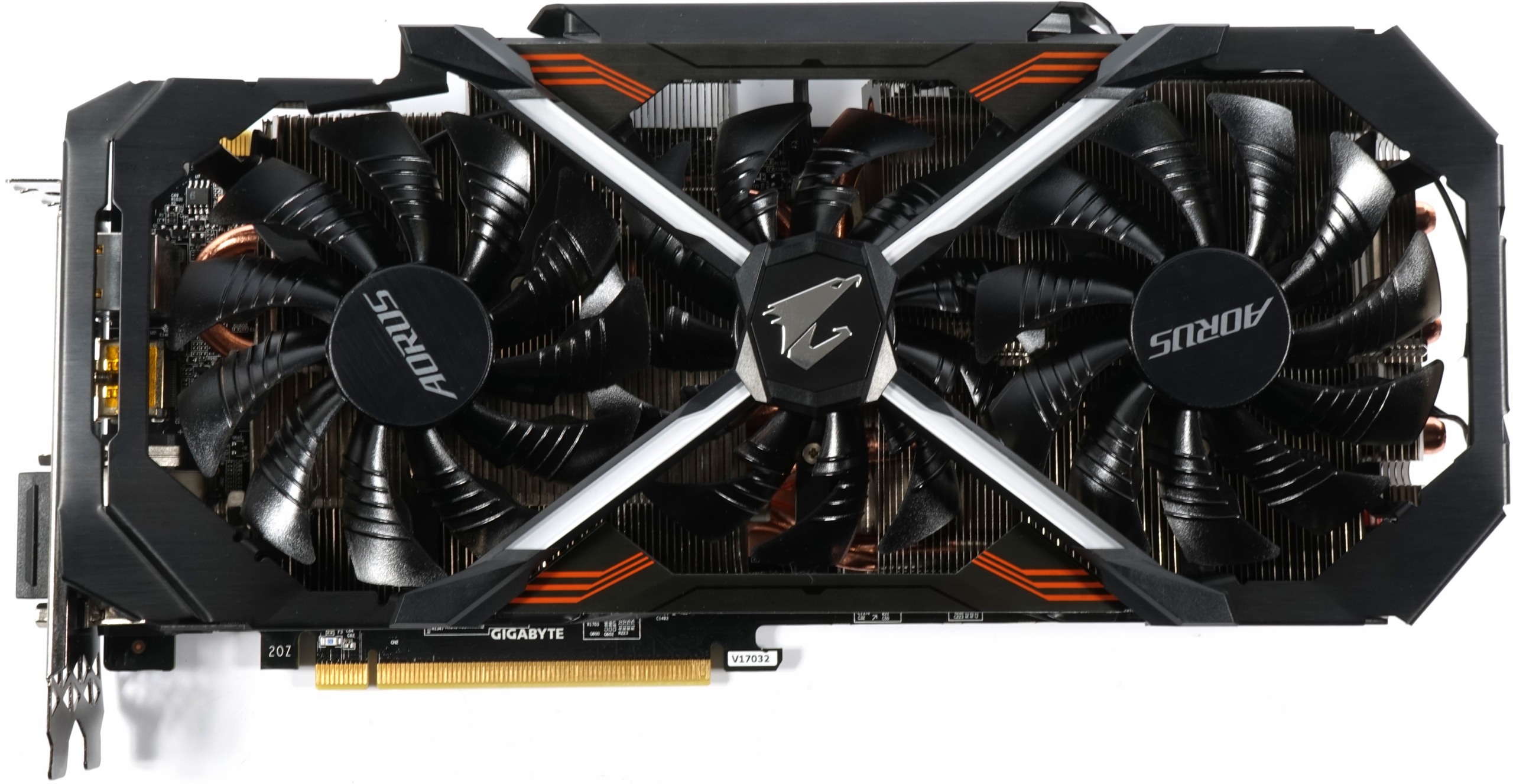 |
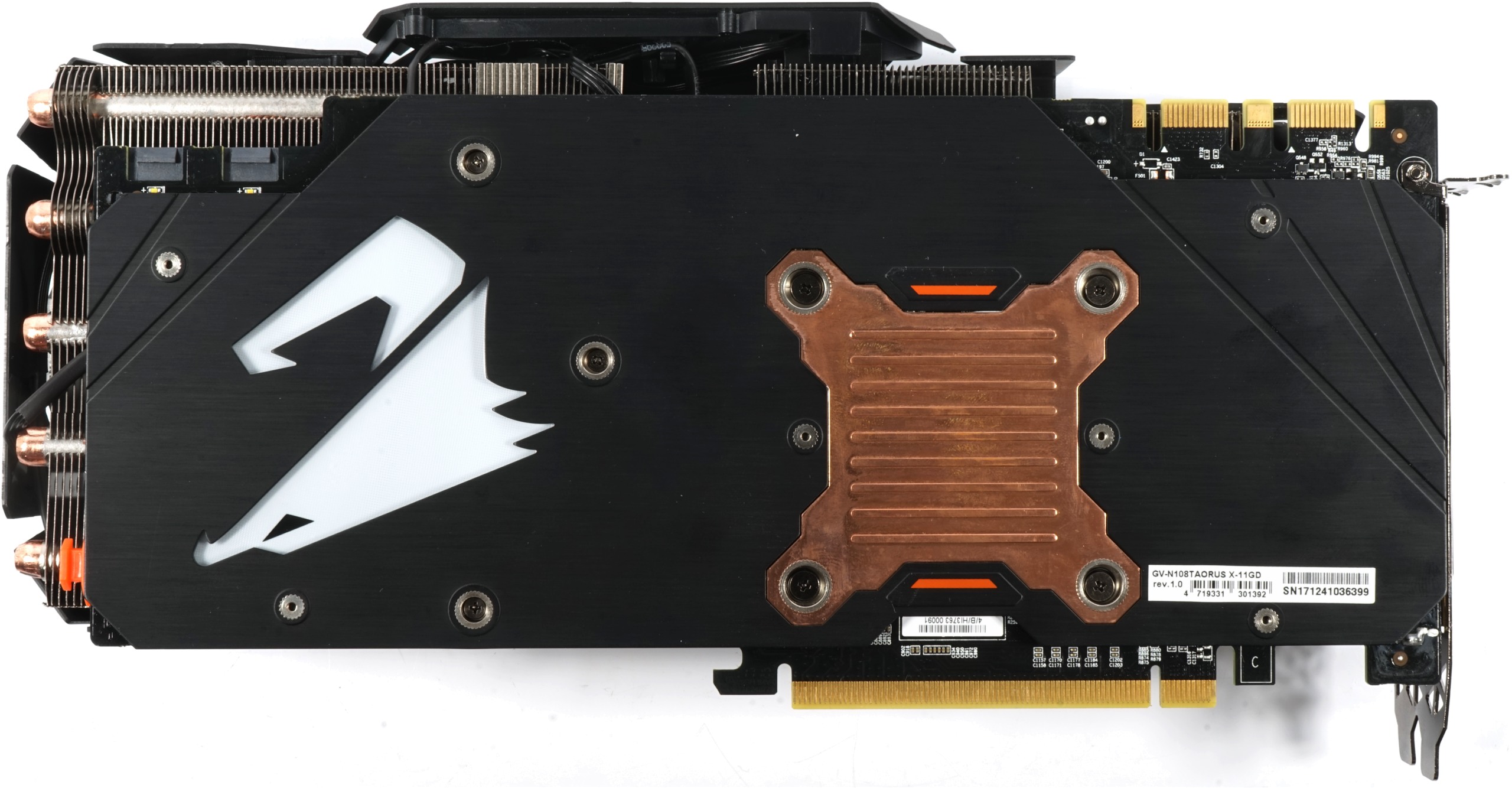 |
The material mix of light metal and some plastic for the cover is good and cool and follows the new design line consistently. The top is characterized by the RGB backlit Aorus logo and a fan stop indicator, the two 8-pin power supply connectors sit 180° rotated at the top of the board.

The bottom and top show the vertical slat orientation of the cooler and a very elaborateLY held VRM heat sink, which actively cools other assemblies. We will also be testing for this.

The end of the map shows five 8 mm heatpipes for the right part of the radiator structure. However, from this side the sixth, a 6 mm heatpipe, is barely visible from the outside. But more on that later. With regard to VR glasses, Aorus relies on two HDMI 2.0 ports on the slot panel, as well as three DisplayPort 1.4 jacks and a dual-link DVI-D connector (picture right). In addition, there is another HDMI connection internally at the end of the card (picture left)
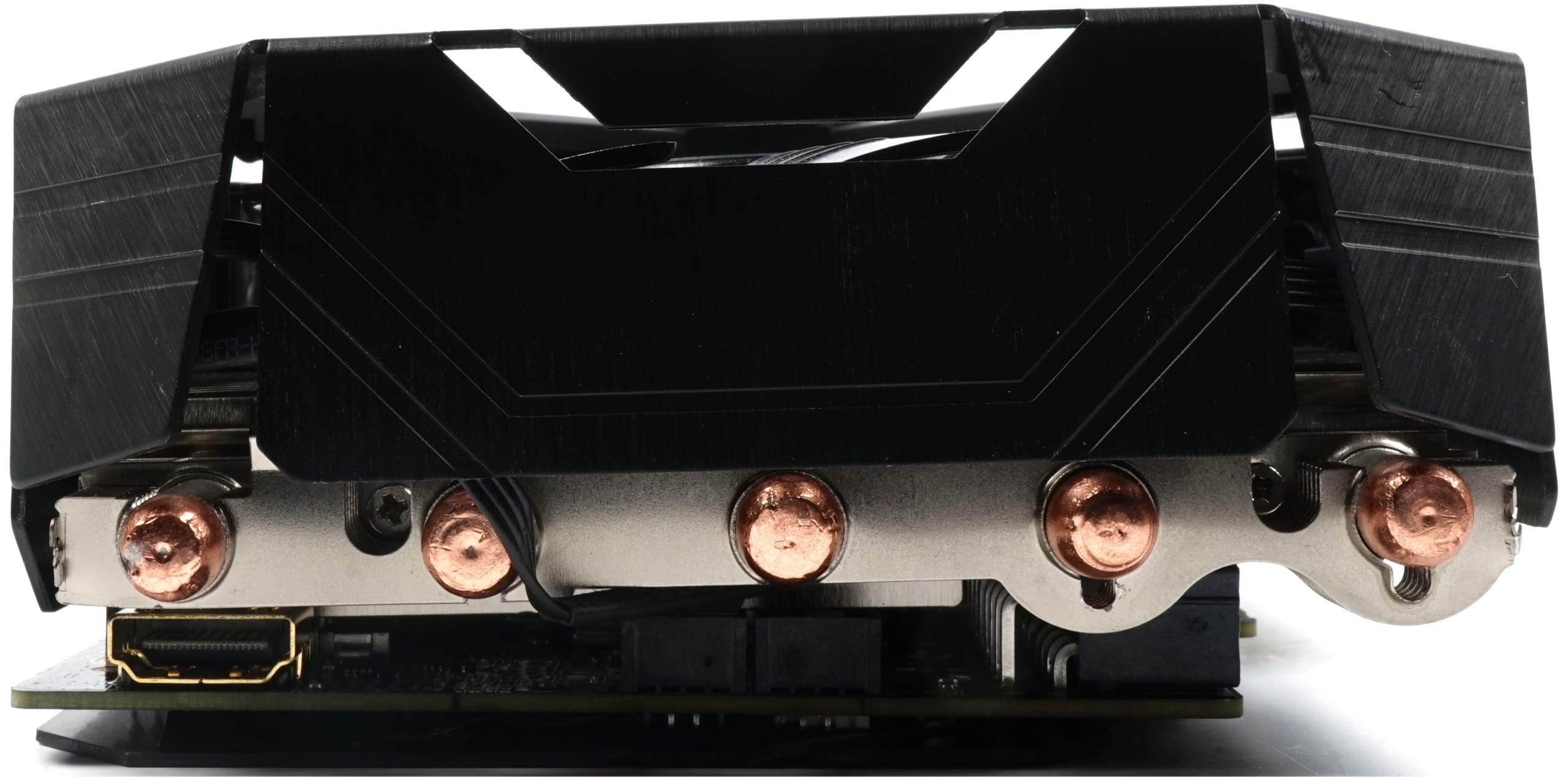 |
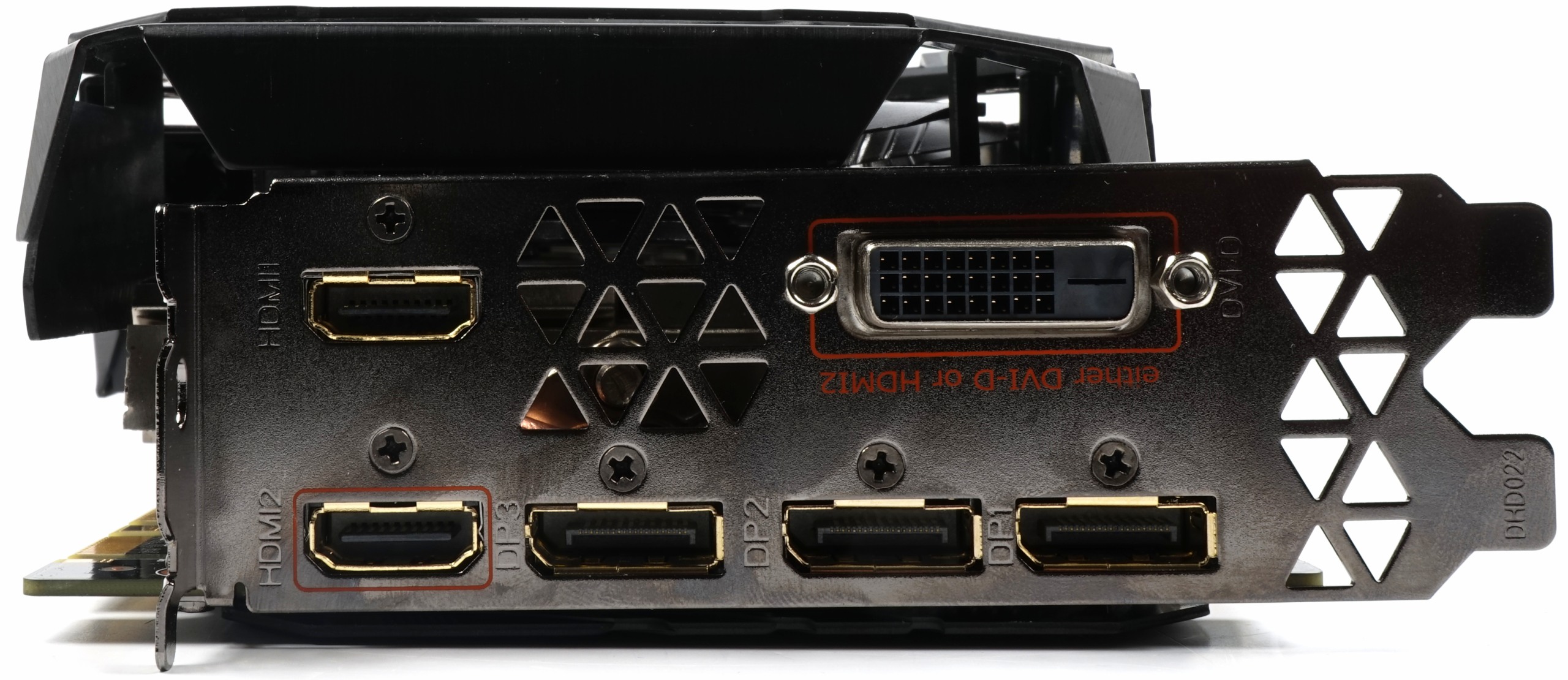 |
Since there are no suitable video switches with 6 lanes, Aorus installs two individual controllers, which also requires two BIOSes. But we will come back to that in a while.
BIOS Flash and Aorus Tool
Today's test was done with the current BIOS version F4, which is based on Nvidia's source BIOS 86.02.39.00.9E, which is now also running much more stable because Nvidia has made various improvements. The older F3 BIOS, on the other hand, is based on the rather vulnerable 86.02.39.00.5, so it is important to recommend a flash here. In addition, Gigabyte has lowered the power target to 250 watts for identical takrates in default mode, because this is sufficient. If you like it faster, up to 375 watts (!) are available via software. We recommend "VGA@BIOS Utility" for the Flash Gigabytes. (Download for tool and F4 BIOS)
But the whole thing is a bit tricky, because the card has an interestingly solved dual BIOS because of the two separate video switches. If you use DVI-D or display port, or HDMI 1, which can flash the AD bios. If you want to use HDMI 2 or the front HDMI 3, you can flash the BIOS AH. Both variants explain the overview image below.
We strongly advise against using the special OC mode in the Aorus tool (currently) and instead use third-party external tools such as the MSI Afterburner and manual settings (more on that later).
Specifications
The GPU-Z screenshot shows us the most important key data in advance, whereby the actual boost achieved with our model was significantly higher:
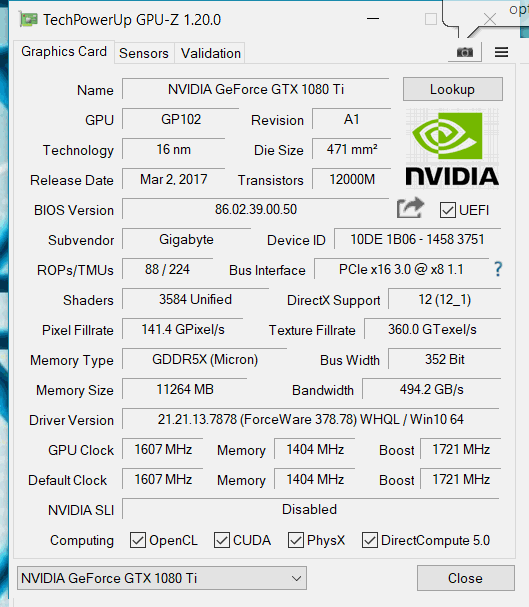
Finally, the whole thing again as a tabular comparison to the other relevant graphics card models:
| Nvidia Titan X – (Pascal) Mr President, I would like to |
Nvidia Geforce GTX 1080 Ti FE |
Aorus GTX 1080 Ti Extreme Edition |
Nvidia Geforce GTX 1080 FE |
Nvidia Geforce GTX 980 Ti |
|
|---|---|---|---|---|---|
| Gpu |
GP102 | GP102 | GP102 | GP104 | GM200 |
| CUDA cores |
3584 | 3584 | 3584 | 2560 | 2816 |
| Base clock | 1417 MHz | 1480 MHz | 1607 MHz |
1607 MHz | 1000 MHz |
| Boost clock |
1531 MHz+ | 1582 MHz+ | 1721 MHz |
1733 MHz+ | 1076 MHz+ |
| Memory Size & Type |
12 GByte GDDR5X |
11 GByte GDDR5X |
11 GByte GDDR5X |
8 GByte GDDR5X |
6 GByte GDDR5 |
| The size |
471 mm2 | 471 mm2 | 471 mm2 | 314 mm2 | 601 mm2 |
| Technology |
16 nm | 16 nm | 16 nm | 16 nm | 28 nm |
| Transistors |
12 billion | 12 billion | 12 billion | 7.2 billion | 8 billion |
| Streaming Multiprocessors (SM) |
28 | 28 | 28 |
20 | 22 |
| GFLOPS (basic clock) |
10.157 | 10.609 | 11.068 |
8.228 | 5.632 |
| Texture Units |
224 | 224 | 224 | 160 | 176 |
| Texture fill rate |
317.4 GT/s | 331.5 GT/s | 360 GT/s |
257.1 GT/s | 214 GT/s |
| Rops |
96 | 88 | 88 |
64 | 96 |
| Pixel fill rate |
136 GPix/s | 130.24 GPix/s | 141.4 GPix/s |
114.2 GPix/s | 116.7 GPix/s |
| Storage data rate |
10 Gbps | 11 Gbps | 11 Gbps | 10 Gbps | 7 Gbps |
| Storage bus |
384 bits | 352 bits | 352 bits | 256 bits | 384 bits |
| Memory bandwidth |
480 GByte/s | 484 GByte/s | 484 GByte/s | 320 GByte/s | 336 GByte/s |
| L2 cache |
3 MByte | 2816 KByte | 2816 KByte | 2 MByte | 3 MByte |
| Tdp |
250 watts | 250 watts | 330 watts |
180 watts | 250 watts |
Test system and measurement methods
The new test system and the methodology have already been described in great detail in the basic article "How We Test Graphics Cards" (English: "How We Test Graphics Cards") and therefore, for the sake of simplicity, we now only refer to this detailed Description. So if you want to read everything again, you are welcome to do so. However, we have improved CPU and cooling once again in order to largely exclude possible CPU bottle necks for this fast card.
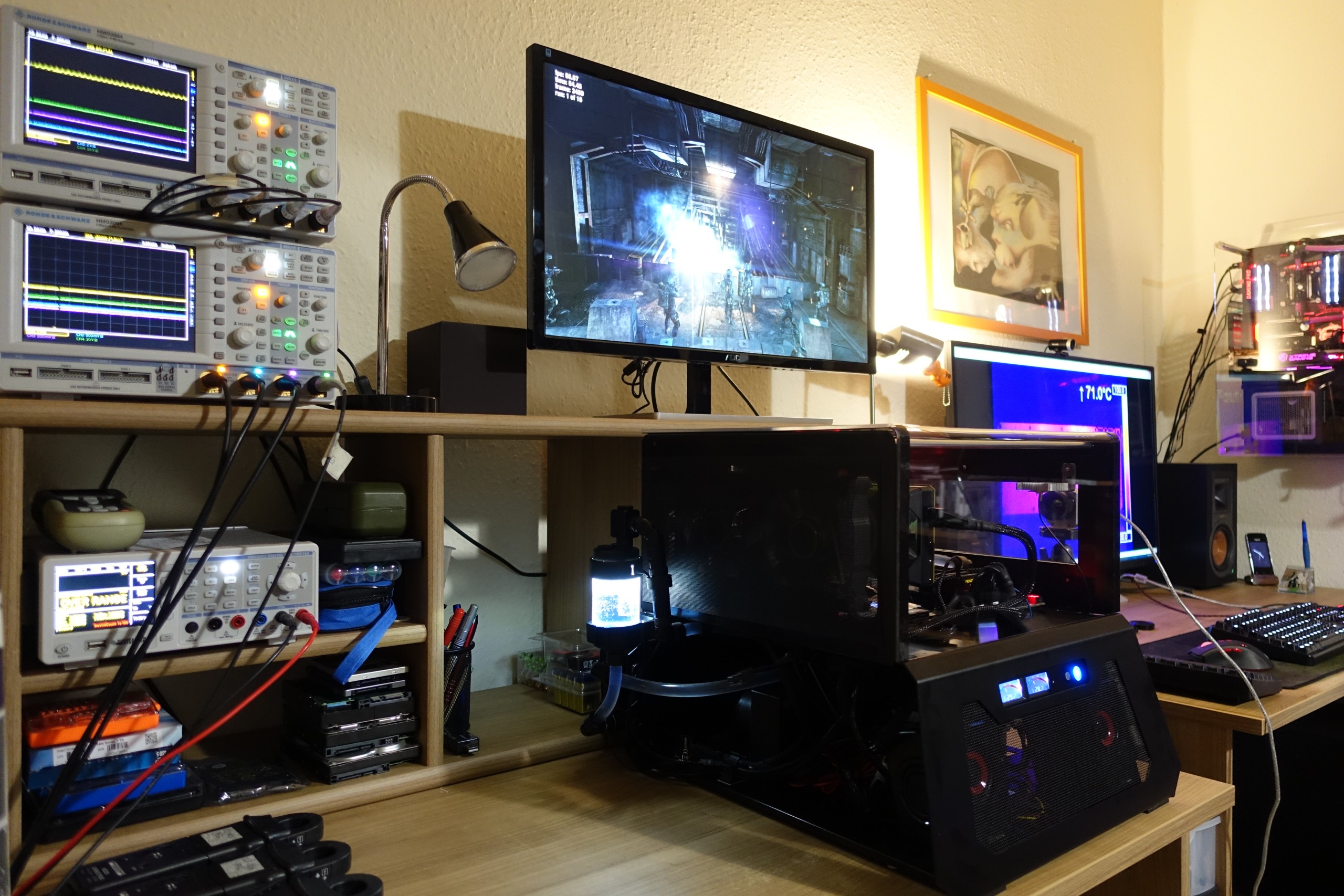
If you are interested, the summary in table form quickly provides a brief overview:
| Test systems and measuring rooms | |
|---|---|
| Hardware: |
Intel Core i7-6900K -4.3GHz MSI X99S XPower Gaming Titanium Corsair Vengeance DDR4-3200 1x 1 TByte Toshiba OCZ RD400 (M.2, System SSD) 2x 960 GByte Toshiba OCZ TR150 (Storage, Images) Be Quiet Dark Power Pro 11, 850-watt power supply Windows 10 Pro (all updates) |
| Cooling: |
Alphacool Ice Block XPX Alphacool Ice Age 2000 Chiller 2x Be Quiet! Silent Wings 3 PWM (Closed Case Simulation) Thermal Grizzly Kryonaut (for cooler change) |
| Housing: |
Lian Li PC-T70 with expansion kit and modifications Modes: Open Benchtable, Closed Case |
| Power consumption: |
non-contact DC measurement on the PCIe slot (Riser-Card) non-contact DC measurement on the external PCIe power supply Direct voltage measurement on the respective feeders and on the power supply 2x Rohde & Schwarz HMO 3054, 500 MHz multi-channel oscillograph with memory function 4x Rohde & Schwarz HZO50, current togor adapter (1 mA to 30 A, 100 KHz, DC) 4x Rohde & Schwarz HZ355, touch divider (10:1, 500 MHz) 1x Rohde & Schwarz HMC 8012, digital multimeter with storage function |
| Thermography: |
Optris PI640, infrared camera PI Connect evaluation software with profiles |
| Acoustics: |
NTI Audio M2211 (with calibration file) Steinberg UR12 (with phantom power for the microphones) Creative X7, Smaart v.7 own low-reflection measuring room, 3.5 x 1.8 x 2.2 m (LxTxH) Axial measurements, perpendicular to the center of the sound source(s), measuring distance 50 cm Noise in dBA (Slow) as RTA measurement Frequency spectrum as a graph |














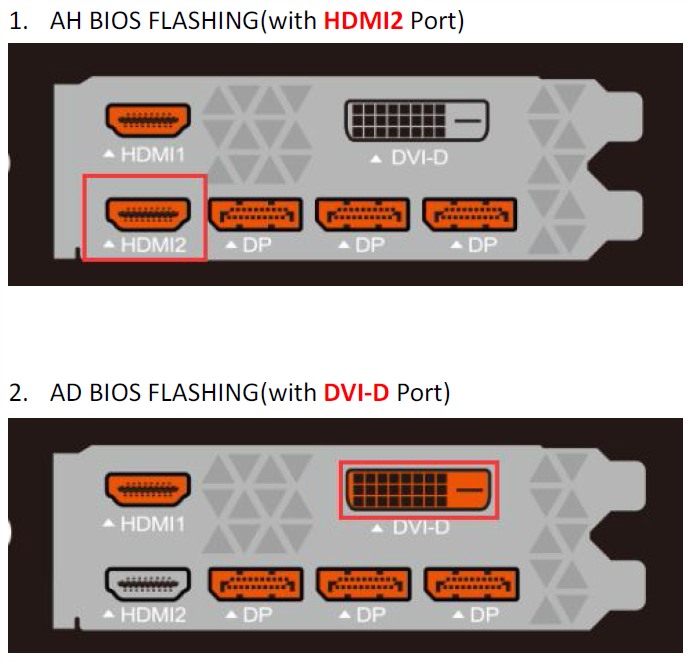


















Kommentieren